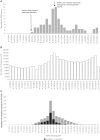Acute Flaccid Myelitis in the United States, August-December 2014: Results of Nationwide Surveillance
- PMID: 27318332
- PMCID: PMC5709818
- DOI: 10.1093/cid/ciw372
Acute Flaccid Myelitis in the United States, August-December 2014: Results of Nationwide Surveillance
Abstract
Background: During late summer/fall 2014, pediatric cases of acute flaccid myelitis (AFM) occurred in the United States, coincident with a national outbreak of enterovirus D68 (EV-D68)-associated severe respiratory illness.
Methods: Clinicians and health departments reported standardized clinical, epidemiologic, and radiologic information on AFM cases to the Centers for Disease Control and Prevention (CDC), and submitted biological samples for testing. Cases were ≤21 years old, with acute onset of limb weakness 1 August-31 December 2014 and spinal magnetic resonance imaging (MRI) showing lesions predominantly restricted to gray matter.
Results: From August through December 2014, 120 AFM cases were reported from 34 states. Median age was 7.1 years (interquartile range, 4.8-12.1 years); 59% were male. Most experienced respiratory (81%) or febrile (64%) illness before limb weakness onset. MRI abnormalities were predominantly in the cervical spinal cord (103/118). All but 1 case was hospitalized; none died. Cerebrospinal fluid (CSF) pleocytosis (>5 white blood cells/µL) was common (81%). At CDC, 1 CSF specimen was positive for EV-D68 and Epstein-Barr virus by real-time polymerase chain reaction, although the specimen had >3000 red blood cells/µL. The most common virus detected in upper respiratory tract specimens was EV-D68 (from 20%, and 47% with specimen collected ≤7 days from respiratory illness/fever onset). Continued surveillance in 2015 identified 16 AFM cases reported from 13 states.
Conclusions: Epidemiologic data suggest this AFM cluster was likely associated with the large outbreak of EV-D68-associated respiratory illness, although direct laboratory evidence linking AFM with EV-D68 remains inconclusive. Continued surveillance will help define the incidence, epidemiology, and etiology of AFM.
Keywords: acute flaccid myelitis; enterovirus; limb weakness; polio; surveillance.
Published by Oxford University Press for the Infectious Diseases Society of America 2016. This work is written by (a) US Government employee(s) and is in the public domain in the US.
Conflict of interest statement
Figures


References
-
- World Health Organization. Report of the interim meeting of the technical consultative group (TCG) on the global eradication of poliomyelitis. Geneva, Switzerland: WHO; Nov 9–11, 2002. 2003.
-
- Solomon T, Willison H. Infectious causes of acute flaccid paralysis. Curr Opin Infect Dis. 2003;16:375–81. - PubMed
-
- Solomon T, Kneen R, Dung NM, et al. Poliomyelitis-like illness due to Japanese encephalitis virus. Lancet. 1998;351:1094–7. - PubMed
MeSH terms
Grants and funding
LinkOut - more resources
Full Text Sources
Other Literature Sources
Miscellaneous

